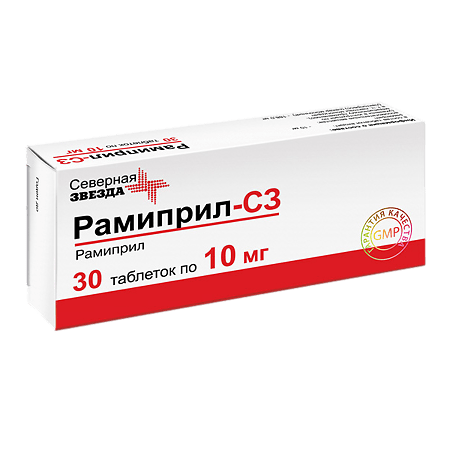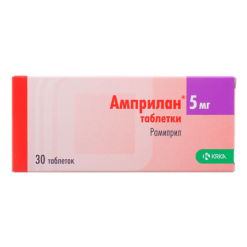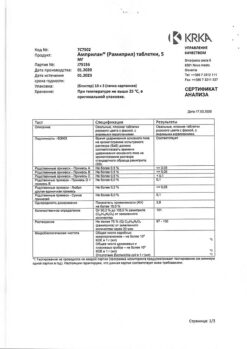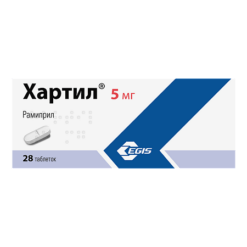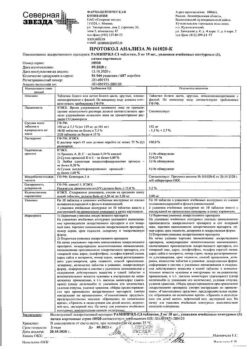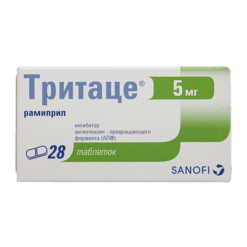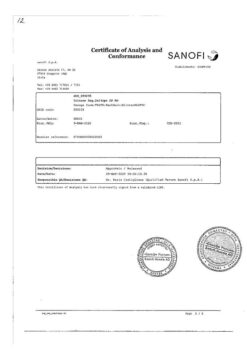No products in the cart.
Ramipril-SZ, tablets 10 mg 30 pcs
€4.94 €4.39
Description
Ramipril-SZ is an ACE inhibitor. It is a prodrug from which the active metabolite ramiprilat is formed in the body. It is believed that the mechanism of antihypertensive action is associated with competitive inhibition of ACE activity, which reduces the rate of conversion of angiotensin I into angiotensin II, which is a powerful vasoconstrictor. The decrease in angiotensin II concentration results in a secondary increase in plasma renin activity by eliminating the negative feedback of renin release and directly reducing aldosterone secretion. Due to its vasodilator effect, it decreases RPO (post-load), congestion pressure in the pulmonary capillaries (preload) and resistance in the pulmonary vessels; it increases cardiac minute volume and exercise tolerance.
In patients with signs of chronic heart failure after myocardial infarction, ramipril reduces the risk of sudden death, progression of heart failure to severe/resistant failure, and reduces hospitalizations for heart failure.
It is known that ramipril significantly reduces the incidence of myocardial infarction, stroke and cardiovascular death in patients with increased cardiovascular risk due to vascular disease (CHD, previous stroke or peripheral vascular disease) or diabetes with at least one additional risk factor (microalbuminuria, arterial hypertension, increased total cholesterol, low HDL, smoking).
Reduces overall mortality and the need for revascularization procedures, slows the onset and progression of chronic heart failure. Both in patients with and without diabetes mellitus, ramipril significantly reduces the existing microalbuminuria and the risk of nephropathy. These effects are noted in patients with both elevated and normal BP.
The hypotensive effect of ramipril develops in about 1-2 h, peaks within 3-6 h, and lasts at least 24 h.
Indications
Indications
– Essential hypertension.
– Chronic heart failure (as part of combination therapy, in particular in combination with diuretics).
– Diabetic or non-diabetic nephropathy, preclinical and clinically pronounced stages, including with severe proteinuria, especially when combined with arterial hypertension.
– Reducing the risk of myocardial infarction, stroke or cardiovascular mortality in patients at high cardiovascular risk:
• in patients with confirmed coronary heart disease, a history of myocardial infarction or without it, including patients who have undergone percutaneous transluminal coronary angioplasty, coronary artery bypass grafting;
• in patients with a history of stroke;
• in patients with occlusive lesions of peripheral arteries;
• in patients with diabetes mellitus with at least one additional risk factor (microalbuminuria, arterial hypertension, increased plasma concentrations of TC, decreased plasma concentrations of HDL-C, smoking).
Heart failure that developed during the first few days (from 2 to 9 days) after acute myocardial infarction (see section “Pharmacodynamics”).
Pharmacological effect
Pharmacological effect
Pharmacological properties
Pharmacodynamics
Formed under the influence of “liver” enzymes, the active metabolite of ramipril, ramiprilat, is a long-acting ACE inhibitor, which is a peptidyl dipeptidase. ACE in blood plasma and tissues catalyzes the conversion of angiotensin I to angiotensin II and the breakdown of bradykinin. Therefore, when ramipril is taken orally, the formation of angiotensin II decreases and bradykinin accumulates, which leads to vasodilation and a decrease in blood pressure (BP).
An increase in the activity of the kallikrein-kinin system in the blood and tissues determines the cardioprotective and endothelioprotective effects of ramipril due to the activation of the prostaglandin system and, accordingly, an increase in the synthesis of prostaglandins that stimulate the formation of nitric oxide (NO) in endothelial cells. Angiotensin II stimulates the production of aldosterone, so taking ramipril leads to a decrease in aldosterone secretion and an increase in serum potassium ions.
By reducing the concentration of angiotensin II in the blood, its inhibitory effect on renin secretion by negative feedback is eliminated, which leads to an increase in plasma renin activity.
It is assumed that the development of some undesirable reactions (in particular, “dry” cough) is also associated with an increase in bradykinin activity.
In patients with arterial hypertension, taking ramipril leads to a decrease in blood pressure in the “lying” and “standing” positions, without a compensatory increase in heart rate (HR). Ramipril significantly reduces total peripheral vascular resistance (TPVR), causing virtually no changes in renal blood flow and glomerular filtration rate. The hypotensive effect begins to appear 1-2 hours after ingestion of a single dose of the drug, reaching its greatest value after 3-9 hours, and persists for 24 hours.
During a course of treatment, the hypotensive effect can gradually increase, usually stabilizing by 3-4 weeks of regular use of the drug and then persisting for a long time. Sudden discontinuation of the drug does not lead to a rapid and significant increase in blood pressure (no withdrawal syndrome),
In patients with arterial hypertension, ramipril slows down the development and progression of myocardial and vascular wall hypertrophy.
In patients with chronic heart failure, ramipril reduces peripheral vascular resistance (reducing afterload on the heart), increases venous capacity and reduces left ventricular filling pressure, which, accordingly, leads to a decrease in preload on the heart. In these patients, when taking ramipril, there is an increase in cardiac output, ejection fraction and improved exercise tolerance.
In diabetic and non-diabetic nephropathy, taking ramipril slows down the rate of progression of renal failure and the time of onset of end-stage renal failure and, thereby, reduces the need for hemodialysis or kidney transplantation. In the initial stages of diabetic or non-diabetic nephropathy, ramipril reduces the severity of albuminuria.
In patients with a high risk of developing cardiovascular diseases due to either vascular lesions (diagnosed coronary heart disease, history of occlusive peripheral artery disease, history of stroke), or diabetes mellitus with at least one additional risk factor (microalbuminuria, arterial hypertension, increased concentrations of total cholesterol (TC), decreased concentrations of high-density lipoprotein cholesterol (HDL-C), smoking), adding ramipril to standard therapy significantly reduces the incidence of myocardial infarction, stroke and mortality from cardiovascular causes.
In addition, ramipril reduces overall mortality rates, as well as the need for revascularization procedures, and slows down the onset or progression of chronic heart failure.
In patients with heart failure that developed in the first days of acute myocardial infarction (days 2-9), taking ramipril, starting from days 3 to 10 of acute myocardial infarction, reduces the risk of mortality (by 27%), the risk of sudden death (by 30%), the risk of progression of chronic heart failure to severe (III-IV functional class according to the MUNA classification)/resistant to therapy (by 27%). %), the likelihood of subsequent hospitalization due to the development of heart failure (by 26%).
In the general population of patients, as well as in patients with diabetes mellitus, both with arterial hypertension and with normal blood pressure, ramipril significantly reduces the risk of developing nephropathy and microalbuminuria. Pharmacokinetics
After oral administration, ramipril is rapidly absorbed from the gastrointestinal tract (50-60%). Eating slows down its absorption, but does not affect the completeness of absorption. Ramipril undergoes extensive first-pass metabolism/activation (mainly in the liver by hydrolysis), resulting in the formation of its only active metabolite, ramiprilat, whose ACE inhibitory activity is approximately 6 times greater than that of ramipril.
In addition, as a result of the metabolism of ramipril, diketopiperazine, which does not have pharmacological activity, is formed, which is then conjugated with glucuronic acid; ramiprilat is also glucuronidated and metabolized to diketopiperazine acid.
The bioavailability of ramipril after oral administration ranges from 15% (for a dose of 2.5 mg) to 28% (for a dose of 5 mg). The bioavailability of the active metabolite, ramiprilat, after oral administration of 2.5 mg and 5 mg of ramipril is approximately 45% (compared to its bioavailability after intravenous administration in the same doses).
After oral administration of ramipril, maximum plasma concentrations of ramipril and ramiprilat are reached after 1 and 2-4 hours, respectively. The decrease in plasma concentrations of ramiprilat occurs in several stages: a distribution and elimination phase with a half-life (T1/2) of ramiprilat of approximately 3 hours, then an intermediate phase with a T1/2 of ramiprilat of approximately 15 hours, and a final phase with a very low plasma concentration of ramiprilat and a T1/2 of ramiprilat of approximately 4-5 days.
This final phase is due to the slow release of ramiprilat from its strong binding to ACE receptors. Despite the long final phase, with a single oral dose of ramipril during the day at a dose of 2.5 mg or more, the equilibrium plasma concentration of ramiprilat is achieved after approximately 4 days of treatment. With a course prescription of the drug, the “effective” T1/2, depending on the dose, is 13-17 hours.
The binding to plasma proteins is approximately 73% for ramipril, and 56% for ramiprilat.
After oral administration of radiolabeled ramipril (10 mg), 39% of the radioactivity is excreted through the intestines and about 60% by the kidneys. After oral administration of 5 mg of ramipril in patients with bile duct drainage, almost equal amounts of ramipril and its metabolites are excreted by the kidneys and intestines during the first 24 hours after administration.
Approximately 80-90% of the metabolites in urine and bile were identified as ramiprilat and ramiprilat metabolites. Ramipril glucuronide and ramipril diketopiperazine account for approximately 10-20% of the total amount, and the content of unmetabolized ramipril in urine is approximately 2%.
Animal studies have shown that ramipril is secreted into breast milk.
In case of impaired renal function with creatinine clearance (CC) less than 60 ml/min. excretion of ramiprilat and its metabolites by the kidneys slows down. This leads to an increase in plasma concentrations of ramiprilat, which decreases more slowly than in patients with normal renal function.
When taking ramipril in high doses (10 mg), impaired liver function leads to a slower first-pass metabolism of ramipril to active ramiprilat and a slower elimination of ramiprilat.
In healthy volunteers and patients with arterial hypertension, after two weeks of treatment with ramipril at a daily dose of 5 mg, no clinically significant accumulation of ramipril and ramiprilat is observed. In patients with chronic heart failure, after two weeks of treatment with ramipril at a daily dose of 5 mg, a 1.5-1.8-fold increase in plasma concentrations of ramiprilat and the area under the pharmacokinetic concentration-time curve (AUC) is observed.
In healthy elderly volunteers (65-76 years), the pharmacokinetics of ramipril and ramiprilat do not differ significantly from those in young healthy volunteers.
Special instructions
Special instructions
Before starting treatment with Ramipril-SZ, it is necessary to eliminate hyponatremia and hypovolemia. In patients who have previously taken diuretics, it is necessary to discontinue them or at least reduce their dose 2-3 days before starting to take Ramipril-SZ (in this case, the condition of patients with chronic heart failure should be carefully monitored, due to the possibility of their developing decompensation due to an increase in circulating blood volume).
After taking the first dose of the drug, as well as when increasing its dose and/or the dose of diuretics (especially loop diuretics), it is necessary to ensure careful medical monitoring of the patient for at least 8 hours so that appropriate measures can be taken in a timely manner in case of an excessive decrease in blood pressure.
If Ramipril-SZ is used for the first time or at a high dose in patients with increased activity of the RAAS, their blood pressure should be carefully monitored, especially at the beginning of treatment, since these patients have an increased risk of an excessive decrease in blood pressure (see section “With caution”).
In case of malignant arterial hypertension and heart failure, especially in the acute stage of myocardial infarction, treatment with Ramipril-SZ should only be started in a hospital setting.
In patients with chronic heart failure, taking the drug can lead to the development of a pronounced decrease in blood pressure, which in some cases is accompanied by oliguria or azotemia and rarely by the development of acute renal failure.
Caution should be exercised when treating elderly patients, as they may be particularly sensitive to ACE inhibitors; in the initial phase of treatment, it is recommended to monitor renal function indicators (see also section “Dosage and Administration”).
In patients for whom a decrease in blood pressure may pose a certain risk (for example, in patients with atherosclerotic narrowing of the coronary or cerebral arteries), treatment should begin under strict medical supervision.
Caution should be exercised during physical activity and/or hot weather due to the risk of increased sweating and dehydration with the development of arterial hypotension due to a decrease in circulating blood volume and a decrease in sodium levels in the blood.
It is not recommended to drink alcohol during treatment with Ramipril-SZ.
Transient arterial hypotension is not a contraindication for continuing treatment after stabilization of blood pressure. If severe arterial hypotension reoccurs, the dose should be reduced or the drug discontinued.
Cases of angioedema of the face, extremities, lips, tongue, pharynx or larynx have been observed in patients treated with ACE inhibitors. If swelling occurs in the face (lips, eyelids) or tongue, or difficulty swallowing or breathing, the patient should immediately stop taking the drug. Angioedema localized in the area of the tongue, pharynx, or larynx (possible symptoms: difficulty swallowing or breathing) can be life-threatening and requires urgent measures to relieve it: subcutaneous administration of 0.3-0.5 mg or intravenous drip of 0.1 mg of epinephrine (under the control of blood pressure, heart rate and ECG) followed by the use of glucocorticosteroids (iv, intramuscularly, or internally); Intravenous administration of antihistamines (antagonists of Hg and H2-histamine receptors) is also recommended, and in case of insufficiency of Sgesterase enzyme inactivators, the need to administer C,-esterase enzyme inhibitors in addition to epinephrine can be considered. The patient should be hospitalized and monitored until symptoms are completely relieved, but not less than 24 hours.
Cases of intestinal angioedema, manifested by abdominal pain with or without nausea and vomiting, have been observed in patients receiving ACE inhibitors; in some cases, angioedema of the face was simultaneously observed. If a patient develops the symptoms described above during treatment with ACE inhibitors, the possibility of developing intestinal angioedema should be considered when making a differential diagnosis.
Treatment aimed at desensitization to insect venom (bees, wasps) and concomitant use of ACE inhibitors can initiate anaphylactic and anaphylactoid reactions (for example, decreased blood pressure, shortness of breath, vomiting, allergic skin reactions), which can sometimes be life-threatening. During treatment with ACE inhibitors, hypersensitivity reactions to insect venom (for example, bees, wasps) develop faster and are more severe. If desensitization to insect venom is necessary, the ACE inhibitor should be temporarily replaced with an appropriate drug of a different class.
Life-threatening, rapidly developing anaphylactoid reactions, sometimes leading to shock, have been described with the use of ACE inhibitors during hemodialysis or plasma filtration using certain high-flux membranes (for example, polyacrylonitrile membranes) (see also membrane manufacturer’s instructions). It is necessary to avoid the combined use of Ramipril-SZ and this type of membrane, for example, for urgent hemodialysis or hemofiltration.
In this case, it is preferable to use other membranes or avoid taking ACE inhibitors. Similar reactions were observed with low-density lipoprotein apheresis using dextran sulfate. Therefore, this method should not be used in patients receiving ACE inhibitors. In patients with impaired liver function, the response to treatment with Ramipril-SZ may be either enhanced or weakened. In addition, in patients with severe liver cirrhosis with edema and/or ascites, significant activation of the RAAS is possible, so special care should be taken when treating these patients (see also section “Dosage and Administration”). Before surgery (including dental surgery), it is necessary to warn the surgeon/anesthesiologist about the use of ACE inhibitors.
It is recommended to closely monitor neonates exposed in utero to ACE inhibitors for hypotension, oliguria, and hyperkalemia. In oliguria, it is necessary to maintain blood pressure and renal perfusion by administering appropriate fluids and vasoconstrictors. Neonates are at risk for oliguria and neurological disorders, possibly due to decreased renal and cerebral blood flow due to the reduction in blood pressure caused by ACE inhibitors.
Monitoring laboratory parameters before and during treatment with Ramipril-SZ (up to 1 time per month in the first 3-6 months of treatment)
Monitoring kidney function (determining serum creatinine concentrations)
When treating with ACE inhibitors, it is recommended to monitor renal function in the first weeks of treatment and subsequently. Particularly careful monitoring is required in patients with acute and chronic heart failure, impaired renal function, after kidney transplantation, patients with renovascular diseases, including patients with hemodynamically significant unilateral renal artery stenosis in the presence of two kidneys (in such patients, even a slight increase in serum creatinine concentration may be an indicator of decreased renal function).
Monitoring electrolyte concentrations Regular monitoring of serum potassium levels is recommended. Particularly careful monitoring of potassium levels in the blood serum is required for patients with impaired renal function, significant disturbances in water and electrolyte balance, and chronic heart failure.
Monitoring hematological parameters (hemoglobin concentration, number of leukocytes, erythrocytes, platelets, leukocyte formula)
It is recommended to monitor indicators of a general blood test to identify possible leukopenia. More regular monitoring is recommended at the beginning of treatment and in patients with impaired renal function, as well as in patients with connective tissue diseases or in patients simultaneously receiving other drugs that can change the peripheral blood picture (see section “Interaction with other drugs”).
Monitoring the number of leukocytes is necessary for the early detection of leukopenia, which is especially important in patients with an increased risk of its development, as well as at the first signs of infection. If neutropenia is detected (the number of neutrophils is less than 2000/μl), discontinuation of treatment with ACE inhibitors is required.
If symptoms due to leukopenia appear (for example, fever, enlarged lymph nodes, tonsillitis), urgent monitoring of the peripheral blood picture is necessary. If signs of bleeding appear (tiny petechiae, red-brown rashes on the skin and mucous membranes), monitoring the number of platelets in the peripheral blood is also necessary.
Determination of the activity of “liver” enzymes, the concentration of bilirubin in the blood
If jaundice or a significant increase in the activity of liver enzymes appears, treatment with Ramipril-SZ should be stopped and medical supervision of the patient should be provided.
Impact on the ability to drive vehicles and operate machinery
During treatment with Ramipril-SZ, it is necessary to refrain from engaging in potentially hazardous activities, including driving a vehicle, that require increased concentration and speed of psychomotor reactions, because While taking it, you may experience dizziness, decreased speed of psychomotor reactions, and decreased attention, especially after taking the first dose.
Active ingredient
Active ingredient
Ramipril
Composition
Composition
1 tablet contains:
active substance: ramipril – 10 mg,
excipients: lactose monohydrate (lactopress) (milk sugar) – 188.0 mg; magnesium stearate – 2.0 mg.
Pregnancy
Pregnancy
Ramipril-SZ is contraindicated during pregnancy, as it may have adverse effects on the fetus: impaired development of the fetal kidneys, decreased blood pressure in the fetus and newborns, impaired renal function, hyperkalemia, hypoplasia of the skull bones, oligohydramnios, contracture of the limbs, deformation of the skull bones, pulmonary hypoplasia.
Therefore, before starting to take the drug in women of childbearing age, pregnancy should be excluded.
If a woman is planning a pregnancy, treatment with ACE inhibitors should be discontinued.
If pregnancy is diagnosed during treatment with Ramipril-SZ, you should stop taking it as soon as possible and transfer the patient to take other drugs, the use of which will have the least risk for the child.
If treatment with Ramipril-SZ is necessary during breastfeeding, then breastfeeding should be discontinued.
Contraindications
Contraindications
– Hypersensitivity to ramipril, other ACE inhibitors, or to any of the components of the drug (see section “Composition”).
History of angioedema (hereditary or idiopathic, as well as after taking ACE inhibitors) – risk of rapid development of angioedema (see section “Side effects”),
– Hemodynamically significant stenosis of the renal arteries (bilateral or unilateral in the case of a solitary kidney).
– Arterial hypotension
(systolic blood pressure less than 90 mm Hg) or conditions with unstable hemodynamic parameters.
– Hemodynamically significant stenosis of the aortic or mitral valve or hypertrophic obstructive cardiomyopathy (HOCM).
– Primary hyperaldosteronism.
– Severe renal failure (creatinine clearance less than 20 ml/min with a body surface of 1.73 m2) (experience of clinical use is insufficient).
– Pregnancy.
– Lactation period.
– Nephropathy, which is treated with glucocorticosteroids, non-steroidal anti-inflammatory drugs, immunomodulators and/or other cytotoxic agents (experience of clinical use is insufficient, see section “Interaction with other drugs”),
– Chronic heart failure in the stage of decompensation (experience of clinical use is insufficient).
– Age up to 18 years (experience of clinical use is insufficient).
– Hemodialysis (experience of clinical use is insufficient). Hemodialysis or hemofiltration using certain membranes with a negatively charged surface, such as high-flow polyacrylonitrile membranes (risk of hypersensitivity reactions) (see sections “Interactions with other drugs”, “Special instructions”),
– Apheresis of low-density lipoproteins using dextran sulfate (risk of hypersensitivity reactions) (see section Special instructions).
– Desensitizing therapy for hypersensitivity reactions to insect venoms, such as bees, wasps (see section “Special instructions”).
Additional contraindications when using the drug Ramipril-SZ in the acute stage of myocardial infarction:
– severe heart failure (functional class IV according to the NYHA classification);
– unstable angina;
– life-threatening ventricular arrhythmias;
– “pulmonary” heart.
WITH CAUTION
– Conditions in which an excessive decrease in blood pressure is especially dangerous (with atherosclerotic lesions of the coronary and cerebral arteries).
– Conditions accompanied by increased activity of the renin-angiotensin-aldosterone system (RAAS), in which, with ACE inhibition, there is a risk of a sharp decrease in blood pressure with deterioration of renal function:
• severe arterial hypertension, especially malignant arterial hypertension;
• chronic heart failure, especially severe or for which other drugs with antihypertensive effects are being taken;
• hemodynamically significant unilateral renal artery stenosis (in the presence of both kidneys);
• previous use of diuretics;
• disturbances in water and electrolyte balance as a result of insufficient intake of liquid and table salt, diarrhea, vomiting, profuse sweating.
Liver dysfunction (lack of experience with use: both strengthening and weakening of the effects of ramipril are possible; in patients with liver cirrhosis with ascites and edema, significant activation of the RAAS is possible, see above Conditions accompanied by increased activity of the RAAS).
– Impaired renal function (creatinine clearance more than 20 ml/min. with a body surface of 1.73 m2) due to the risk of developing hyperkalemia and leukopenia).
– Condition after kidney transplantation.
– Systemic connective tissue diseases, including systemic lupus erythematosus, scleroderma, concomitant therapy with drugs that can cause changes in the peripheral blood picture (possible inhibition of bone marrow hematopoiesis, development of neutropenia or agranulocytosis, see section Interaction with other drugs).
– Diabetes mellitus (risk of developing hyperkalemia).
– Older age (risk of increased hypotensive effect).
– Hyperkalemia.
Side Effects
Side Effects
From the cardiovascular system and blood (hematopoiesis, hemostasis): hypotension (10.7%), incl. postural (2.2%), angina (2.9%), syncope (2.1%), heart failure (2%), myocardial infarction (1.7%), vertigo (1.5%), chest pain (1.1%), less than 1% – arrhythmia, palpitations, hemolytic anemia, myelodepression, pancytopenia, thrombocytopenia, eosinophilia, agranulocytosis; vasculitis
From the gastrointestinal tract: nausea (2.2%), vomiting (1.6%), diarrhea (1.1%), less than 1% – dry mouth or increased salivation, anorexia, dyspepsia, dysphagia, constipation, abdominal pain, gastroenteritis, pancreatitis, hepatitis, liver dysfunction (cholestatic jaundice, fulminant liver necrosis with fatal outcome), changes in the level of transaminases
From the nervous system and sensory organs: dizziness (4.1%), headache (1.2%), asthenia (0.3%), in less than 1% – cerebrovascular disorders, amnesia, drowsiness, convulsions, depression, sleep disorder, neuralgia, neuropathy, paresthesia, tremor, hearing loss, visual impairment.
From the respiratory system: nonproductive cough (7.6%), upper respiratory tract infections, in less than 1% – dyspnea, pharyngitis, sinusitis, rhinitis, tracheobronchitis, laryngitis, bronchospasm.
From the genitourinary system: impaired renal function (1.2%), in less than 1% – proteinuria, oliguria, edema; impotence.
From the skin: urticaria, prurigo, rash, erythema multiforme, photosensitivity.
Other: less than 1% – decreased body weight, anaphylactoid reactions, increased levels of urea nitrogen and creatinine, angioedema (0.3%), arthralgia/arthritis, myalgia, fever, increased titer of antinuclear antibodies, hyperkalemia, changes in enzyme activity, concentrations of bilirubin, uric acid, glucose.
Interaction
Interaction
Contraindicated combinations
– The use of some high-flow membranes with a negatively charged surface (for example, polyacrylonitrile membranes) when performing hemodialysis or hemofiltration; use of dextran sulfate in low-density lipoprotein apheresis
Risk of developing severe anaphylactic reactions.
Not recommended combinations
– With potassium salts, potassium-sparing diuretics (for example, amiloride, triamterene, spironolactone)
A more pronounced increase in serum potassium levels is possible (with simultaneous use, careful monitoring of serum potassium levels is required). Combinations to use with caution
– With antihypertensive drugs (especially diuretics) and other drugs that lower blood pressure (nitrates, tricyclic antidepressants)
Potentiation of the hypotensive effect; when combined with diuretics, serum sodium levels should be monitored.
– With hypnotics, narcotic and non-narcotic analgesics
A more pronounced decrease in blood pressure is possible;
– With vasopressor sympathomimetics (epinephrine) Reducing the hypotensive effect of ramipril, careful monitoring of blood pressure is required.
– With allopurinol, procainamide, cytostatics, immunosuppressants, systemic glucocorticosteroids and other drugs that may affect hematological parameters
Concomitant use increases the risk of developing leukopenia.
– With lithium salts
Increased serum lithium concentration and increased cardio- and neurotoxic effects of lithium.
– With hypoglycemic agents for oral administration (sulfonylurea derivatives, biguanides), insulin
Due to the decrease in insulin resistance under the influence of ramipril, the hypoglycemic effect of these drugs may be enhanced, up to the development of hypoglycemia.
Combinations to Consider
– With non-steroidal anti-inflammatory drugs (indomethacin, acetylsalicylic acid)
The effect of ramipril may be weakened, the risk of renal dysfunction and increased potassium levels in the blood serum may be increased.
– With heparin
An increase in serum potassium levels is possible.
– With sodium chloride
Weakening of the hypotensive effect of ramipril and less effective treatment of symptoms of chronic heart failure.
– With ethanol
Increased vasodilation. Ramipril may increase the adverse effects of ethanol on the body.
– With estrogens
Weakening the hypotensive effect of ramipril (fluid retention).
-Desensitizing therapy for hypersensitivity to insect venoms
ACE inhibitors, including ramipril, increase the likelihood of severe anaphylactic or anaphylactoid reactions to insect venoms.
With the simultaneous use of ACE inhibitors and gold preparations (sodium aurothiomalate) for intravenous administration, a symptom complex has been described, including facial flushing, nausea, vomiting and arterial hypotension.
Overdose
Overdose
Symptoms: excessive peripheral vasodilation with the development of a pronounced decrease in blood pressure, shock; bradycardia, fluid and electrolyte disturbances, acute renal failure, stupor.
Treatment: gastric lavage, taking adsorbents, sodium sulfate (if possible within the first 30 minutes). In the case of a pronounced decrease in blood pressure, the administration of alpha-adrenergic agonists (norepinephrine, dopamine) can be added to therapy to replenish circulating blood volume and restore electrolyte balance. In case of bradycardia refractory to drug treatment, installation of a temporary artificial pacemaker may be required. In case of overdose, it is necessary to monitor serum concentrations of creatinine and electrolytes.
Storage conditions
Storage conditions
At a temperature not exceeding 25 °C
Shelf life
Shelf life
3 years
Manufacturer
Manufacturer
North Star NAO, Russia
Additional information
| Shelf life | 3 years |
|---|---|
| Conditions of storage | At a temperature not exceeding 25 °C |
| Manufacturer | North Star NAO, Russia |
| Medication form | pills |
| Brand | North Star NAO |
Other forms…
Related products
Buy Ramipril-SZ, tablets 10 mg 30 pcs with delivery to USA, UK, Europe and over 120 other countries.

